Simple Steps to Replacing Old Dining Room Table Legs with New Ones
Simple Steps to Replacing Old Dining Room Table Legs with New Ones
Blog Article
From Typical to Modern: Locate the Suitable Dining-room Table Legs for Your Design
While timeless designs such as cabriole and turned legs stimulate a feeling of timeless class, modern styles like barrette and geometric alternatives present a chance for striking aesthetic interest. As you think about these elements, the concern continues to be: just how can you seamlessly integrate these varied leg designs to create an unified eating experience?
Recognizing Table Leg Styles
The selection of dining-room table leg styles can dramatically affect both the looks and capability of the room. Each leg design adds special aesthetic aspects and functional functions, catering to varied layout choices and usage demands. Comprehending these styles is important for choosing the best table that aligns with your overall indoor layout vision.
For circumstances, tapered legs supply a tidy, classic appearance that can improve a room's elegance, while stand bases supply stability and make best use of legroom, making them ideal for smaller sized areas. Hairpin legs, a hallmark of mid-century modern-day style, introduce a commercial flair, permitting an airy, open feel. Trestle legs stimulate rustic appeal, offering durable support and a feeling of eternity.
Moreover, the option of products plays a considerable role. Wood legs can bring warmth and structure, whereas metal choices frequently share a streamlined, contemporary ambiance. Ultimately, understanding table leg designs is important for developing a natural dining location that reflects individual design while guaranteeing usefulness and comfort. By attentively thinking about these components, you can improve both the useful and aesthetic charm of your eating area.
Traditional Table Leg Options
When choosing dining-room table legs, traditional options commonly personify timeless sophistication and workmanship. These layouts mirror a rich heritage and a commitment to quality, making them suitable for those that value timeless aesthetic appeals.
Among one of the most famous typical leg designs is the cabriole leg, identified by its elegant curved form. This design frequently features decorative carvings and is most typically located in Queen Anne and Chippendale furnishings. An additional preferred alternative is the transformed leg, which boasts a collection of smooth, rounded forms that supply a timeless appearance while preserving stability.
Additionally, the straight leg, while easy, uses a strong and unadorned framework that can mix flawlessly with a selection of tabletop designs. For those drawn to ornate detailing, claw-and-ball feet legs evoke a sense of grandeur and can act as a magnificent focal factor in any type of dining space.
Last but not least, stand bases, although not strictly legs, provide a different typical choice that permits ample legroom and can be magnificently carved. Each of these conventional leg designs adds to the general ambiance of a dining-room, marrying feature with aesthetic appeal.

Modern Table Leg Layouts
Modern table leg styles offer a varied range of designs that highlight tidy lines and ingenious products. These layouts often focus on functionality while acting as striking focal points within an eating space. Minimal visual appeals prevail, with legs crafted from click to read materials such as steel, glass, and engineered timber, which add to a airy and modern feel.
One prominent layout is the hairpin leg, identified by its slender, conical structure that supplies stability without frustrating the tabletop (dining room table legs). This design is usually discovered in mid-century modern-day furniture and can easily match numerous table shapes. An additional trend is making use of geometric forms, where legs might take on angular or asymmetrical kinds, adding visual rate of interest and a touch of virtuosity

Mixing Designs for Special Areas
Commonly, home owners look for to produce special dining spaces that reflect their individual design by blending various design elements. This strategy enables the unification of diverse aesthetic appeals, leading to a harmonious yet distinct setting. Coupling a rustic wood table with sleek, modern steel legs can produce an eye-catching comparison that raises the space's overall allure.
In addition, incorporating vintage table legs with contemporary tabletops can stimulate a feeling of background while maintaining a modern perceptiveness. Such mixes not just showcase specific preference but additionally motivate creativity, permitting house owners to curate a space that really feels both personal and inviting.
Color plays a vital function in this mixing procedure; choosing table legs that enhance or contrast with the existing shade scheme can boost visual rate of interest. For example, whitewashed legs can soften the boldness of a dark table surface area, creating a well balanced visual.
Tips for Picking the Right Legs
Picking the right table legs is important for accomplishing both functionality and aesthetic allure in your eating space. Begin by taking into consideration the overall style of your space. Typical settings take advantage of legs that include detailed carvings or turned styles, while modern spaces may ask for sleek, minimalist designs.
Following, assess the height and security of the legs. dining room table legs. Standard table vary in between 28 to 30 inches in elevation, so make certain the legs complement this dimension for convenience. Additionally, durable products, such as wood or steel, can boost stability and long life
Evaluate the leg shape also-- alternatives include directly, tapered, or stand designs. Straight legs offer a traditional appearance, while conical legs can add a touch of beauty. Pedestal bases provide enough legroom and are suitable for smaller rooms.
Conclusion
In recap, selecting the perfect dining-room table legs requires careful consideration of both modern and traditional designs. Typical alternatives such as cabriole and transformed legs supply classic beauty, while modern styles like barrette and geometric shapes offer a contemporary touch. By harmonizing leg design, elevation, and product with the general decoration, a cohesive and welcoming ambience can be accomplished. Eventually, the chosen table legs need to mirror the preferred aesthetic, enhancing the eating experience within the area.
The range of dining area table leg styles can significantly affect both the appearances and performance of the space. Inevitably, understanding table leg designs is necessary for creating a hop over to here natural dining location that shows individual style while making certain functionality and comfort.One of the most legendary conventional leg styles is the cabriole leg, defined by its graceful curved form. Straight legs provide a classic appearance, while tapered legs can include a touch of beauty.In recap, choosing the perfect dining area table legs needs careful factor to consider of both standard and modern-day designs.
Report this page